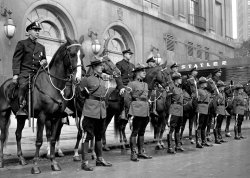
MAY CONTAIN NUTS

Search Shorpy
SHORPY ART

Framed or unframed, desk size to sofa size, printed by us in Arizona and Alabama since 2007. Explore now.
Join and Share
Ad-Free Shorpy
Shorpy is funded by you. Patreon contributors get an ad-free experience.
Learn more.

Recent comments
- Snazzy skirt
- Carbon Arc Lamps
- Illuminate us
- I remember it well
- I can't prove it
- Complicated then, forgotten now
- Bryan-Stevenson
- Skinny is as skinny does
- How do you rest in peace
- Riding the footboards
- Alas, hidden from view
- Baldwin Diesels
- Exclusive pump
- Bananas, Oysters and Smokey Joe
- Details, Details
- What's that building to the left of the tower?
- Coal Barges
- Bromo-Seltzer
- Inner harbor
- The Basin
- What a headache!
- Giant stepladder?
- Yeah, it was cold
- Love those coats
- Link & Pin Days Remnant
- Baldwin 62303
- Baldwin VO-1000
- Cold
- No expense spared
- Tough Guys
Member Photos
The Shorpy
Print Emporium
Print Emporium
Search Shorpy
Search results -- 30 results per page
- Grand Circus Park: 1908
- Detroit circa 1908. "Corner of Grand Circus Park." If a circle can be said to have a corner. Maybe more like a pie slice. ... Posted by Dave - 11/19/2014 - 11:55am -
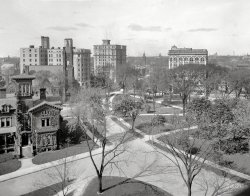
- Detroit Grand Circus Park, approx 1920
- ... Statler Hotel I was able to match the image to Detroit's Grand Circus Park. The next guess is the date. Possibly about 1915-20. View full ... Posted by bhappel - 09/21/2009 - 5:04am -
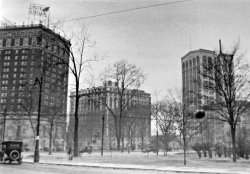
- Grand Circus Park: 1919
- Detroit circa 1919. "Grand Circus Park from Detroit Athletic Club." The Statler and Tuller hotels, and the two ... Posted by Dave - 08/21/2012 - 6:31pm -
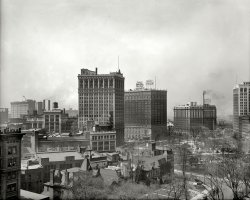
- Eureka Vacuum: 1912
- ... glass negative. View full size.
View from Grand Circus Park Detroit renumbered all of their street addresses in 1920. ... Posted by Dave - 08/04/2021 - 3:43pm -
![Eureka Vacuum: 1912 Detroit, Michigan, circa 1912. "Woodward Avenue." A shopper's paradise. Meet you in an hour at Cinnabon. Detroit Publishing glass negative. View full size.
View from Grand Circus ParkDetroit renumbered all of their street addresses in 1920. Therefore, the old 260 address on the left indicates that this photo was actually taken from Grand Circus Park where Park Ave. (foreground) intersects with Woodward.
View Larger Map
View Larger Map
I am disappointed!!Just when I was in the mood for some Chop Suey and not a place in sight.
Player Pianos, Fifth FloorHope they had a good elevator!
Woodward buildings still standI think the current street view above is a little off. I think this picture was taken from a spot just south of Grand Circus park between where the Whitney Building and Broderick Tower are now. Most of the buildings on the right including Grinnell Brothers still stand. Also the block of buildings on the left south of the Pontchartrain Hotel are still standing.
Re What were they thinking?"When this is 'View full size' we're all be dead."
PianosI counted 6 piano stores not 3.
Grinnell BrothersGrinnell Brothers (sign on right side of street) was a Detroit area institution all the way into the 1980's, when the entire chain went out of business. They had stores in every area mall and not only sold pianos, but other musical instruments, lessons, records, sheet music, pianos rolls, everything to do with music. Wonderful stores, they just couldn't keep up with the times.
What were they thinking?I love pictures like this! This is a frozen second in the lives of all these people. Where were they all going? What were they thinking about? Who was worried, or excited, and about what? Who had just gotten good news, or bad news? Who was going to work, or to do something fun? Who was pregnant, or had new a child, or grandchild?
I also wonder what was playing at the theater. I assume it was live theater, primarily, although there were quite a few short films, and the production of feature-length films was only a few years away.
If I had my choiceI have to agree with user "tterrace", I'd much rather walk down the 1910 version of Woodward than today's, oh if just for a day. What sights to behold.
What happenedGrowing up in Detroit and remembering my mother taking me downtown on the streetcar and shopping at Hudsons, Kerns, and Crowleys and then for being a good kid she took me across the street to Kresge's downstairs and bought me a waffle sandwich which I will never forget. I often hear the phrase "you can't go back" but I miss and loved the way the city was.
Mouse Furs, yuck!Oh wait, it's Mau's Furs.
Never mind.
What Could It Be?I wonder what the three objects are on the street to the left and in front of the second streetcar. No one is near them.
[Newspaper bundles, thrown off the streetcar for pickup by Woodward Avenue newsies, would be my guess. - Dave]
Prettier?I won't get in to the prettier/not prettier debate, but based on Anon. Tipster's Google Street View links, the adjectives that occur to me are more along the lines of : 1910: alive, vibrant, visually diverse, inviting; 2011: sterile, lifeless, visually monotonous, inhospitable.
Hats anyone?As far as I can tell, with the exception of one small boy, everyone is wearing a hat. Ah, those were the days.
Lots of piano storesI counted three different piano shops on this block, Bush & Lane, Manufacturer's and Melville Clark. Was this a sort of "piano district" at the time, or were pianos just ubiquitous enough in parlours of the day that several dealers on a single block was nothing unusual?
[Player pianos were, I think, something like the plasma TVs of their day. - Dave]
"Spirit of Detroit"The buildings at the left have been replaced by the statue "Spirit of Detroit" and Coleman Young Municipal Center. There's an automatic "people mover" tram running almost directly above where the camera was. This part of Detroit is quite a bit prettier now than it was a century ago.
View Larger Map
View Larger Map
Urgent need to tinkleIs there anyplace on this street that sells pianos??
Of course it's DetroitMore cars here than any other 1910 picture we have seen.
One thing, I think I'm pretty knowledgeable about antique cars, but does anyone know what the heck that round tank on the rear of the car at center right is? Has me puzzled.
[Something steamy, perhaps. Condenser? Reservoir? - Dave]
Are You Properly Attired? The boy about to board the trolley seems to be, although the ring around his shoulders could also be a part of whatever he's dragging behind him. A lamp maybe? Hard to tell - I run out of pixels before I can enlarge/enhance it enough. Still, it looks like a bicycle tire to me. Perhaps other Shorpists will have better data.
Bush & Lane Piano Co.on the left had their main manufacturing facility in Holland, MI. They went out of business in 1930, victims of the Depression as were many other piano manufacturers.
Right RulesLooks like all the cars of the time were right hand drive. Anyone know when we decided to change?
[Gradually. - Dave]
Majestic TheatreThe Majestic Theatre opened in April 1915 per its website, so I wonder it that dates this post to 1915.
[Detroit had several Majestic Theatres over the years. The Majestic in this photo opened in 1908 at 231 Woodward. - Dave]
Piano StoresOK, I count at least six piano stores! And at least three fur stores.
More piano storesI'm counting possibly seven piano stores--Bush and Lane Pianos, Manufacturers Piano Co, Cable Piano Co, Tarrand Pianos, Grinnel Bros Pianos, Melville Clark Pianos, and another just to the upper right of the Grinnel Sign. I'm surprised that there isn't a Wurlitzer sign somewhere in this. I'm also seeing a Victor Records. Pianos were all the rage for years--before everyone had radios and tv. People learned to play for entertainment for themselves and others.
(The Gallery, Detroit Photos, DPC, Stores & Markets, Streetcars)](https://www.shorpy.com/files/images/4a24401a.thumbnail.jpg)
- The Tuller: 1914
- Detroit, Michigan, circa 1914. "Hotel Tuller, Grand Circus Park." 8x10 inch dry plate glass negative, Detroit Publishing Company. ... Posted by Dave - 08/09/2012 - 10:39pm -
![The Tuller: 1914 Detroit, Michigan, circa 1914. "Hotel Tuller, Grand Circus Park." 8x10 inch dry plate glass negative, Detroit Publishing Company. View full size.
"Half-ironed pants"More on the Tuller from Forgotten Detroit.
[Also has its own Wikipedia entry. - Dave]
The Ol' Lunch WagonThese antecedents of modern-day diners and catering trucks were common features on the streets of large cities at this time, and were often left at construction sites or in places where lots of people were working late shifts in order to quickly feed the workers there. Here is a picture of a similar "night lunch" wagon on the streets of Detroit, sporting the name of a locally famous hotel that may be familiar to regular Shorpy followers.
Re: Quick LunchSure looks like a diner. Those steps look treacherous. They also look like they could be mass produced.
Right across the street.Is that the corner of a diner on the right? I'd like to see pictures of that.
Windows without glass?In the first level beneath what might be a penthouse, there appear to be several windows without glass or sashes. Also, is that a church next door?
[The side-hinged casements open in. On the left is the Universalist Church of Our Father. - Dave]
AfterthoughtThat top floor looks like they added it after the building was completed.You can't say they didn't get full use of their site! Every square inch is occupied!
[The top floors were added in 1914. - Dave]
Here in DetroitTwo 1914 period Detroit Electrics, identified by their stylish curved front corner windows, at home in their city. Is the intriguing "Qui..." on the right some kind of circus wagon?
["Quick Lunch." Grand Circus means "big circle," which was the shape of the park.- Dave]
ElectricLooks like two Baker Electrics in this picture. If I am wrong I am sure there will be an immediate correction. Go for a ride in one with Jay Leno.
(The Gallery, Cars, Trucks, Buses, Detroit Photos, DPC)](https://www.shorpy.com/files/images/4a25483a.thumbnail.jpg)
- Advanced Vaudeville: 1912
- ... is nearly all concrete today. I remember waiting for the Grand River streetcar at that location in the 1940s.
Sigh.
Miles to Go ... after the show he returned to the Statler Hotel on Grand Circus Park, where the house doctor diagnosed a ruptured appendix. He was ... Posted by Dave - 08/05/2012 - 10:54am -
![Advanced Vaudeville: 1912 Detroit circa 1912. "Griswold Street from Capitol Park." Home of the Miles Theater and "Advanced Vaudeville" -- you'll laugh, you'll cry, you'll need a slide rule and a thesaurus. 8x10 glass negative, Detroit Publishing. View full size.
Advanced VaudevilleWow--am reading Rick Altman's terrific book "Silent Film Sound" at the moment, so I have just learned that "Advanced Vaudeville" was actually another term for movies c. 1910, or for a vaudeville program combining movies, performers, and illustrated songs. No slide rule required!
I'll biteMr. Gallagher: "Who was that cosine I saw you with last night?"
Mr. Shean: "That was no cosine, that was my tangent."
Some there, most notThe two buildings at right center are still there; the others have been replaced. Capitol Park was converted to an outdoor bus terminal and is nearly all concrete today. I remember waiting for the Grand River streetcar at that location in the 1940s.
Sigh.
Miles to GoThe Miles was demolished in 1927 along with other buildings to its left to make way for the Griswold Building, which was completed in 1929. The theatre switched from vaudeville to movies in the early 1920s. Sources indicate the 1000-seat Miles installed a two-manual, 29-rank Hillgreen-Lane organ at a cost of $9,600 in 1921, which was an unusually large pipe organ for a theatre that size.
The Mayor is dead. Long live the MayorWilliam Richert, mayor of Detroit, died on June 16, 1912. Possibly why the half-staff flags.
[And let's not forget the Titanic. - Dave]
Half-StaffWho was being mourned in Detroit circa 1912?
Relaxing in the parkWhy did we ever give up spaces to relax and read a paper downtown outdoors? We've lost so much with air-conditioned cars and buildings. Maybe I overstate, but this park looks so inviting, and "planned" for pedestrian use. Shops and theaters surround the park. Just a wonderful gathering place. Wish more towns and cities had them centrally located for everyone's benefit.
ProgressFuture additions to the skyline in this view: the mighty Penobscot, the David Stott and the magnificent Guardian Building. Capitol Park has certainly seen a lot of change and is currently being restored to again be pedestrian-friendly.
RE: Relaxing in the parkThe park is still there, but it's a lot less green.
It's still being utilized by people from the looks of it.
As far as thriving shops and theaters...well, there's room to grow!
View Larger Map
Houdini Played HereAs Griswold Street stretches towards Canada and the Detroit River, one can spy the marquee for the Garrick Theater on the left, ... it's in the first block south of Capital Park.
The Garrick was another famous theater in Detroit, and could lay claim as being the last place Houdini performed, Oct. 24, 1926. He took the stage with a 104 fever; after the show he returned to the Statler Hotel on Grand Circus Park, where the house doctor diagnosed a ruptured appendix. He was rushed to Grace Hospital in the early hours of the 25th where he died Oct. 31, 1926.
The Garrick was torn down for the David Stott building in the late 1920s.
Houdini, has not expressed an opinion on the demolition.
Minnie Schoenberg Marxtterrace, did you know that Al Shean was an uncle of the Marx Brothers? His sister, Minnie, was the mother of that incredible group. She tried to turn her boys into a respectable, well-mannered, singing group. Fortunately, she was only minimally successful at that endeavor! I wonder if they played the Miles Theater?
Jeff, thanks for the definition of "Advanced Vaudeville"!
Capitol SquareThis is a recent photo I purchased of the square from the opposite angle. I'm wondering if anyone can date it. You can see it larger at Tattered and Lost Photographs. I'd love to know more about the image.
(The Gallery, Detroit Photos, DPC, Streetcars)](https://www.shorpy.com/files/images/4a24618a.thumbnail.jpg)
- Up Woodward: 1908
- Detroit circa 1908. "Up Woodward Avenue from Grand Circus Park." A record number of "moonlight tower" arc lamp standards on view ... Posted by Dave - 08/08/2012 - 7:37pm -
![Up Woodward: 1908 Detroit circa 1908. "Up Woodward Avenue from Grand Circus Park." A record number of "moonlight tower" arc lamp standards on view here. 8x10 inch dry plate glass negative, Detroit Publishing Company. View full size.
Moonlight TowersAnd all this time I've considered cell phone towers a major symbol of our modern crassness, as another reason to long for a return to the Edwardian Era of enlightened tastes!
Perhaps we're not so bad after all.
Where's a DeLorean when you need one! I wish someone would hurry up and invent a time machine so I can go back and live here. Living in the Detroit area today, and having spent a lot of time in this particular area represented in this photograph, I would give anything to be back "there" today, instead of what we have now. Even if it meant I had to shovel coal, or clean up after horses.
View Larger Map
Who needs a nifty ESPN smart phone app?When you can get the latest baseball scores posted on the roof of a building!
Smokestacks and SpiresIndustry and faith--a winning combination in my book!
Also, I wonder who won the Detroit/Chicago game. It got cut off in the fifth inning.
Let There Be Light!How many moonlight towers does everyone count? I can see maybe twelve, thirteen or fourteen. If we could enlarge it even further ...
Scoreboard!I noticed that just past the first church on the left there's a partial view of a baseball scoreboard showing the Tigers and the White Stockings. That's how folks got the score back then. They were wired from the stadium to various points and posted so fans could keep up in near real-time conditions. Some of these places also served simple food and beer and were generally an all-male gathering spot.
High anxietyWho's gonna be the one to go up there and change a lightbulb?
[Note that the lights are on pulleys and can be lowered to the ground. - Dave]
High (and low) WiresHow are all these tower guy-wires anchored? Two look like they are converging in the small park on the right but I can't follow them to the end. Were they fastened to something right on the ground or perhaps out of reach on a pole?
I believe this is 1907In the 1907 World Series, Game 5, the Chicago Cubs scored a run in each inning of the first and second as shown on the outdoor baseball scoreboard in this shot. It didn't match any scores from the 1908 series.
Baseball gameWith the trees still bare this is early in the baseball season (April or May). If back then they used the convention of away team on top and home team on the bottom like now then this puts the picture at April 14th (season opener) or April 16th.
on 4/14/1908 Sox 15 Tigers 8.
on 4/16/1908 Tigers 4 Sox 2.
Unfortunately box scores are hard to find earlier than about 1918.
[This photo was made in the fall, not the spring. - Dave]
And in TimeThis Woodward Avenue, in about 55 years, would become famous for the fact that many Auto manufacturers would come out and compare models by running out Woodward. And that the tradition still lives on.
Not that they were "racing," ahem, Officer, cough.
The lights and the pulleysThe pulleys are for raising and lowering the work platform, visible near the bottom of the tower. This feature has been disabled on the surviving towers in Austin.
Softly glowing celltowersThat would be kind of cool -- big ol' twisty CFL bulbs dotting the modern landscape.
Austin transplanted towersIn a March 1964 visit to Austin, Texas, when I first saw some of these Moonlight Towers that had been transplanted there I first thought that they were for some type of microwave relay system. They are plotted on a USGS quadrangle map (1954) of the area and supposedly when viewed from above once made the outline of a five-pointed star.
1907 perhaps? Tigers vs. CubsI think the baseball game might not be the Detroit Tigers vs. Chicago White Sox, but rather the Tigers and Chicago Cubs. The Tigers and Cubs played each other in the World Series in consecutive years in 1907 and 1908. I think this might be Game 5 of the 1907 World Series.
World Series Game 5 Played on Saturday, October 12, 1907 (D) at Bennett Park
CHI N 1 1 0 0 0 0 0 0 0 - 2 7 1
DET A 0 0 0 0 0 0 0 0 0 - 0 7 2
The convention of listing the home team on the bottom has not always been consistent, and perhaps DETROIT was always listed on top in Detroit. www.retrosheet.org has box scores going back to 1871. To be sure, I'd have to rule out all the regular season games between the White Sox and Tigers, which I have not done...
Off seasonI suppose the picture could have been anytime after October 12, 1907 as that was the last game of the World Series, and therefore the season. I suppose they could have left it up for a while without another game necessitating the change.
Time frameNot only do the long shadows indicate a late afternoon time for the picture, the fact that there aren't any people on the balcony where the box score is displayed makes it likely that the picture was taken sometime after the end of the game (and definitely after the fifth inning). Baseball Almanac says that the game lasted 1:42 (hah!) but doesn't say when it began.
Look at the mastLook at how the base of the moonlight tower in the foreground is anchored to the ground. It tapers to one ordinary steel pole! The structure has guy wire anchors to support it, but it still it doesn't look very sturdy. I wonder if they had difficulty finding enough maintenance people crazy enough to climb these things. It is interesting to note that thousands of similar structures would be used in the radio era, in the years to come.
Game 5First, I think the trees are too bare for October 12. Second, the teams are listed the wrong way -- the Tigers were at home for Game 5, 1908.
Moonlight towers: steampunk for real!I would love to see how well those things really worked.
A lovely September afternoon!Tuesday, Sep 8 L DET 2 CHW 5
Wednesday, Sep 9 W DET 7 CHW 6
Thursday, Sep 10 W DET 6 CHW 5
Friday, Sep 11 L DET 2 CHW 4
Saturday, Sep 12 L DET 1 CHW 2
So tallThe towers seem so tall compared to our average street lights today. Yet, these are undoubtedly the precursors to the tall, multi-fixture light towers around today's modern expressway interchanges. Today's lights also lower to the ground with pulleys.
I wonder how far those old tall towers would throw the light, and how bright they would be compared to today?
Towers and TigersDetroit had more of these moonlight lighting towers than any city in the world - well over 100 at their peak - before they were all taken out in the 1910s in favor of modern street level electric lighting. A few of these Detroit towers were purchased and moved and some are still in use in Austin, Texas.
More here on the evolution of this form of public lighting.
As for the baseball score on the roof on the right, I think it may be from one of the final games of the razor-close 1908 American League pennant race. The Tigers traveled to Chicago for the final series of the season, a 3 game set starting on October 4th, with a 1.5 game lead over Cleveland and a 2.5 game lead over Chicago.
Detroit lost the first two games of the series to the White Sox, and I think the scoreboard shown here may be from one of those 2 games, so probably Oct. 4th or 5th 1908. This set up a climactic final game for the championship. The Tigers won that game 7-0 and claimed their second consecutive American League pennant by a game over Chicago and a half-game over Cleveland.
The AL race, however, was somewhat overshadowed by the National League race, which also came down to a final game, between the New York Giants and Chicago Cubs, necessitated by the infamous "Merkle's Boner" play. The Cubs won, and went on to defeat Detroit 4 games to 1 in the World Series.
Austin TowersThe former Detroit towers here in Austin are still used a lighting as well as historical markers. The one in Zilker Park is turned into our "Xmas tree" each year.
Austin moonlight towersIn the early days when Austin's moonlight towers had carbon-arc lamps, one city employee had the full-time occupation of driving around in a buggy to each tower once a day, hoisting himself up by the internal lift rigging, and adjusting the carbon sticks to their proper gap for making an electrical arc. I suppose all these towers worked that way In the Day.
Three ChurchesThe three large churches visible on the righthand side of the picture along Woodward Avenue are, from front to back: first, the Central United Methodist at 23 E. Adams at Woodward, and built in 1866 (still extant); second, St. John's Episcopal at 2326 Woodward at Fisher Freeway, and built in 1859 (still extant); and third, Woodward Avenue Baptist at 2464 Woodward, and built in 1886 (demolished).
Backward TimeI agree with you. My Grandfathers' house where I lived for a number of years is now part of the baseball park (122 E. Vernor Hwy). I attended the Boy Scouts at Central Methodist Church. My Mom and Dad worked at the Hotel Statler. I also went to the Franklin Elementary School and Cass Technical High School. We have a lot in common and your Google Earth is something for me to view.
(The Gallery, Detroit Photos, DPC, Streetcars)](https://www.shorpy.com/files/images/SHORPY_4a18667a.thumbnail.jpg)
- Chop Suey Canyon: 1916
- ... spots, offering a cheaper alternative to the top hotels of Grand Circus Park: The Hotel Tuller and the Hotel Statler.
View Larger ... Posted by Dave - 07/24/2012 - 9:56pm -
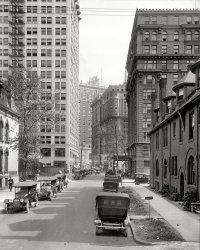
- Hotel Tuller: 1980s
- ... bath. It was also the first hotel built in Detroit's Grand Circus Park district. Lew Whiting Tuller (1869-1957), who erected and operated ... Posted by Dave - 09/14/2011 - 5:01pm -
![Hotel Tuller: 1980s A circa 1980s look at the Tuller Hotel, seen earlier here and here. "Tuller Hotel, 501-521 Park Boulevard. The Tuller Hotel was one of the largest luxury hotels in Detroit in the early twentieth century, with 800 rooms, each with a private bath. It was also the first hotel built in Detroit's Grand Circus Park district. Lew Whiting Tuller (1869-1957), who erected and operated this hotel, was a major builder of hotels and apartment houses in Detroit in the 1900s and 1910s. The three distinct buildings share a common Italian Renaissance styling." Photograph and caption by the Historic American Buildings Survey. View full size.
Mayor Coleman Young EraA more apt description would be that this is the Detroit of the Coleman Young era.
If anyone is interested in seeing the difference between the vacant properties of Detroit against the border of affluent Grosse Pointe, look no further than the satellite photo of Google maps and the Alter Road divider to see an infill landscape (GP) versus plenty of land (Det) where thousands of homes stood less than 20 years ago.
This is the area where Charlton Heston and my father grew up (although neither knew of the other).
You've heard of the Honeymoon SuiteThis must be the Homewrecker Suite.
Afterparty Is this after Charlie Sheen stayed there?
AlmostToo sad for words. I was looking earlier this evening at a series of pictures showing how some of the great buildings in Detroit have fallen into neglect and disarray. A great shame.
Liberalism's Great SocietyLiberalism's Great Society in actual practice, and what they intend to do to our entire country, if we don't stop them.
[This is Reagan-era Detroit, a city whose decline does not have much to do with "liberalism," or politics in general. - Dave]
Downward Spiral Just heard on NPR yesterday how Detroit's population has fallen from a high of 2 million to around 700,000 today. While I knew Detroit was in a bad way I had no idea the depth of its despair. Hard to believe the "Motor City" of my youth in the 50s and 60s has lost its prominence. How quickly it has faded.
I thinkthe Who must have stayed here. And thank you, Dave, for the nippage in the bud of political nonsense. There's already too much snarkery in the world. Shorpy is above all that.
Hold up there, CowboyRadical Liberalism began in the 1960s hippie movement in SanFrancisco while Reagan was still a cowboy riding his pinto across the make believe range. Radical Liberalism's rampant runaway across America is alive and well and great cities in this country are all on the decline because of it. This hotel room is repeated all over America. it's not political, it's a fact.
[Factwise, when the hippies were grooving to the Summer of Love in San Francisco, Ronald Reagan was governor of California. In 2010, Detroit is depopulating as the auto industry there declines. More people would link the export of manufacturing to the free-trade policies of conservative administrations than to any kind of "liberalism." What would really be interesting (or entertaining) would be to lay out the specifics of how "liberalism" is responsible for the condition of this hotel room. As for it being "repeated all over America," the number of ancient abandoned highrise hotels in this country is probably close to zero. - Dave]
I base my comments more on what I see happening in middle america where rampant extremist liberalism deposited its payload, not so much on THIS hotel room in THIS city. Point about Reagan whether he was riding the range or not, is HE had nothing to do with this hotel room. Where do you live? An Ivory Tower, no doubt where you do not have to mingle with the masses. If you are going to let in one political comment then, speaking from a liberal viewpoint, Shorpy will Also cease to exist. [Roll eyes] Interesting comment from the guy making his political statement commending you for not allowing a political statement. [Roll eyes] You run a good site here, but people are hungry in America, keep your nose clean and give us something to enjoy. [nice of you to allow me this conversation--be nice to continue it in person as so much is lost in text]
[Next up on Fox: "Politically Incoherent." - Dave]
Factwise, there have been some good comments, and some who understand the point I was making. You just aren't one of them, Dave. I had thought you to be a smart guy and now I realize you are just a smart-ass guy. I bet you have a small penis, too.
Current Detroit PhotosColor photos of Detroit's sadder side can be seen here:
http://www.marchandmeffre.com/index.html
The Tuller isn't part of the set but others show the loss of what Detroit had been.
Here Comes The Political MessWhy is it some people just have to share their political opinions with you? Please go where they care about your political opinion; you see I could not care less about your political views. Now if you have photos to share you have my attention.
A common cycleMany a respectable hotel has gone through a cycle of decline. This is not a new thing. As fashions move on, the rising cost of redecorating to stay high-end or even respectable, at some point, intersects with falling revenues. Buildings obsolesce, become more costly to maintain, leaving less money for services. Clientele becomes more and more down-market, until the building finally succumbs to decades of neglect. Sometimes, after a decade or so of dereliction, the establishment finds new owners and new capital, and rebounds. The Tuller was not so lucky. As we have seen, some folks are just itching to blame this cycle on '60s liberalism (cue eye-roll), but this cycle played itself out many times before that decade.
PoliticsI think there were some politicians of all types who contributed to the decline of Detroit, most prominently in the mayor's office. That said, Shorpy is a much better place when it is nonpartisan.
Damn Hippies Killed the TullerSorry, I just couldn't help the title. The image came first. The room just creeped me out.
YIKES!Looks like they kept the "DO NOT DISTURB" sign out to long.
I was hereI was one of the architectural team that evaluated the condition of the hotel just before it was demolished, and the seeds of its decline were sown back in the 20's and 30's, and are not the result of liberalism, Reaganomics, or anything more complicated than the poor decisions of the owners. The additions to the hotel, especially the one on Washington Boulevard side, were poorly planned and poorly executed - you had to go outside across a metal fire escape just to get from one side of the hotel to the other! The original hotel could never have been called elegant, and its decor over the years just got worse until a 1950's remodel made it look up to the minute in 1954, but terribly dated by 1960. Every other major hotel in Detroit, the Statler, the Hilton, the Cadillac, the Fort-Shelby, was ruined by 'modernizations' in the 50's, 60's and 70's that replaced or covered the original elegance and classic details in favor of ersatz 'luxury' that faded quickly. The thing that killed them ALL, however, was the opening on the Westin in the Renaissance Center in the early 1970's. How could any old, drafty, non-air conditioned hotel with its rattly elevators, cracked plaster, peeling paint and knocking radiators compete with a 2000 room glass and concrete symbol of the future? Both the Cadillac and the Fort Shelby have been renovated and re-opened, both required complete gutting and both required conversion of half of the building to condos, just to pay the bills. Now these are the hot new properties, and the Westin looks tatty. The Tuller WAS too far gone to save, its fate was sealed in the 1950s.
The '67 riots sealed Detroit's fateIn addition to the usual business cycle of fancy old hotels losing favor to newer "better" hotels, the city of Detroit received a huge black eye 15 to 20 years prior to this photo.
"White flight" was in full swing by the time of the 1967 riot in Detroit. After the riots, the prosperous black population wanted to move out of the city too. The result was the affluent property and business owners moved to the suburbs. Without a reason for wealthy hotel patrons to visit the city why would there be a need for a luxury hotel in the city?
Idiot's delightNobody has pointed out that the Republican party chose to hold its 1980 convention and nominate Ronald Reagan in Detroit. The idea was to showcase the problem city--AND to promise that things would be different. With 30 years' perspective, we can draw conclusions about both of those notions.
The Tiresome Discussion About DetroitWhy must every discussion of my hometown devolve into either tirades about the evils of "liberalism," or none-too-subtle allusions to race (the "Coleman Young wrecked the paradise that was Detroit" angle), or some nasty combination of the two? But oh-so-little consideration seems to be given to the underlying economic structural factors and technological tides that have been much more historically important in making it both the great boom town of the early 20th century and the poster child of urban dissolution in more recent decades.
Jeez o peteI think that the decline of big cities has less to do with the tidal flows of two-party politics, and more to do with the invention that made Detroit what it was, the automobile... and the mass migration of everybody with money out of those cities. Not to mention poor city planning of the 50s-60s that slashed many urban neighborhoods into pieces with freeways. Cities have only begun to recover in the past decade. In any case, I find it difficult to see how hippies are to blame, especially not for our present and future problems considering that generation is nearly in its 70s.
(The Gallery, Detroit Photos, HABS)](https://www.shorpy.com/files/images/339513pu.thumbnail.jpg)
- Open Wide: 1908
- Detroit circa 1908. "Grand Circus building." Named after the large, semicircular park nearby, and home to a curiously high concentration of dentists. 8x10 inch ... Posted by Dave - 07/24/2013 - 9:36am -
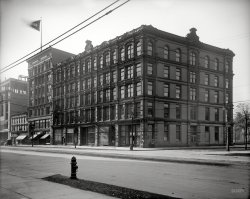
- Statler and Tuller: 1920
- Detroit, Michigan, circa 1920. "Grand Circus Park, looking toward Washington Boulevard, and Hotels Statler and Tuller." 8x10 ... Posted by Dave - 07/24/2012 - 9:55pm -
![Statler and Tuller: 1920 Detroit, Michigan, circa 1920. "Grand Circus Park, looking toward Washington Boulevard, and Hotels Statler and Tuller." 8x10 glass negative. View full size.
Arbuckle, perhapsIs that a theatre marquee in the lower right corner the reads FATTY? This would be about a year before the famous Fatty Arbuckle scandal.
re: ArbuckleLightening up that bit at the lower right does indeed point to the marquee reading both "Fatty Arbuckle" as well as "Talmadge." He worked with Natalie Talmadge in three short comedies 1917-1918.
[The Talmadge on the marquee is Constance. - Dave]
Motor CityThe motor car takeover is nearly complete - there are only two equine holdouts in view.
It's the Adams Theatre marqueeat lower right. It was at 44 Adams Avenue West and opened in 1917 as a vaudeville house before switching to movies the following year. After numerous renovations and direction changes, the Adams finally closed in 1988. The Fine Arts Building it was in was demolished in 2009.
No Happy EndingsThe Tuller was demolished in 1992, and the Statler went down in 2005. Both had sat vacant for well over a decade. They were replaced by... well, nothing yet.
Oh, and the theater in the foreground showing the Fatty Arbuckle movie? It is the then-new Adams (opened in 1917). It was torn down in 2009, except for its facade, which rather spookily stares down empty-eyed on the park across the street
Street level viewHere's a street level view of the Statler and Tuller from a different corner of Grand Circus Park:
https://www.shorpy.com/node/6736?size=_original
ShorpyvilleI have recently been inspired by photos posted here. I call my series "The twilight world of Shorpyville."
[Ooh. Intriguingly eerie! - Dave]
(The Gallery, Cars, Trucks, Buses, Detroit Photos, DPC)](https://www.shorpy.com/files/images/4a25726a.thumbnail.jpg)
- Box Sets: 1904
- ... Reflected in the windows are glimpses of the snow-covered Grand Circus Park located just across the street.
The Ghost of J Pool Could ... Posted by Dave - 08/09/2012 - 6:19pm -
![Box Sets: 1904 Detroit circa 1904. "Whitney-Warner Publishing Co." In the heyday of the parlor piano, sheet music was big business. Crates of the latest hits ready for shipment. 8x10 inch dry plate glass negative, Detroit Publishing Company. View full size.
Smiles!It isn't very often you get to see some real smiles in old photos. Nice!
Fine Wet GoodsGuaranteed to wet your whistle!
The Belle of the PhilippinesThe complete score can be seen online thanks to the University of Alabama Libraries.
I'm Dreaming of a White EasterThis must be April or so. You have the remnants of snow all over the road but it has melted completely off the sidewalks, and most of the people do not feel the need to wear their winter coats.
You get the feeling from the Clockwork Orange looking teenager who has the Goetting box, that this is a rather warm day.
New Titles for 1903"Belle of the Philippines" and "My Dixie Anna" were both published in 1903. "My Dixie Anna" was a featured song in a musical comedy titled "Busy Izzy," a vehicle for the comedian George Sidney, which ran for only eight performances at New York's 58th Street Theatre in March, 1903. A few months later the song was interpolated into the farce comedy "A Son of Rest," which opened at Haverly's 14th Street Theatre on August 17, 1903.
CamouflageThat is some really nice beveled, leaded, etched glass in Bowman's Cafe. I like the way the tree reflected in the plain plate glass fits right in to the overall image. That would be a great subject for its own photo.
And yes, while I'm here I would love a fine wet libation, if you wouldn't mind.
Fine Wet Goods?Mr. Bowman can't fool me - he's running a saloon unless he's a broth mogul.
I bet one of the ladieswas the demonstration pianist. Every sheet music store had one. That's how Louis' second wife, Lil Hardin Armstrong started her musical career—at the Jones Music Store in Chicago.
Is this it?Is this the same "Belle of the Phillipines"? If so this is what it sounded like.
Whiskey, Music and Furs!According to the 1904 Detroit City Directory, this building was located at 10 Witherell. It also housed the offices of Shapiro, Remick & Co. (music publishers) and Edward R. Schremser, a music teacher and the leader of "Schremser's Military Band & Orchestra". To the left is Herman Bowman's saloon at 12 Witherell and on the right is the Asbaugh, Dittrich & Co. Furs at 8 Witherell, which was located on the southeast corner with Woodward Ave. Reflected in the windows are glimpses of the snow-covered Grand Circus Park located just across the street.
The Ghost of J PoolCould that be the ghost of the dentist? Second floor window above No. 8 door.
[On this side of the pond, we call that the third floor. - tterrace]
Yes indeed we will need to talk with the sign painter.
Whitney-WarnerWhy does that name sound familiar?
I wonder if new customers signing a 1-year subscription could get a player piano for only $1 a month and a high-speed telegraph connection?
The Ghost of J PoolSurely it would be the top floor?
This we know for sure this timeCustomer A. H. Goetting of Springfield, Massachusetts, is dead.
An Old-Fashioned PrinterBefore ink-jet printers were... (wait for it)... ink-brush printers!
In this picture an early ink-brush printer is being used to apply shipping labels to the boxes. Notice there is no wire attached to the printer. This photograph shows the earliest known use of 'wireless' printing technology.
(The Gallery, Detroit Photos, DPC, Music)](https://www.shorpy.com/files/images/SHORPY_4a20663a.thumbnail.jpg)
- Ten Cents a Branch: 1916
- ... Detroit circa 1916. "Dime Bank branch, Broadway & Grand Circus Park." Co-starring the Crescent Music Co. and a fine-looking carbon-arc ... Posted by Dave - 12/30/2016 - 7:29pm -
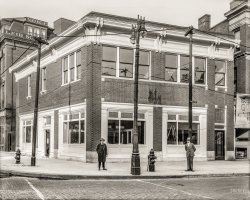
- At the North Pole: 1958
- ... feedback loop, I recall), a white bunny that played a mini grand piano, and a very sad rooster who walked a tightrope. I placed my bet, ... Village when she was a kid. That, and the place with the Circus Trees, which were apparently sold to Busch Gardens not too long ago. ... Posted by tterrace - 06/24/2009 - 5:11pm -
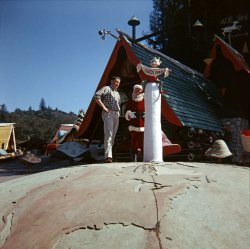
- Upward on Woodward: 1915
- ... circa 1915. "Woodward Avenue -- Whitney Building and Grand Circus Park." 8x10 inch dry plate glass negative, Detroit Publishing Company. ... Posted by Dave - 03/24/2022 - 4:18pm -
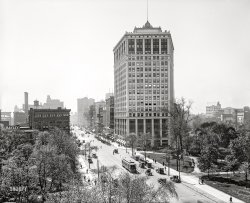
- When Hustle Met Bustle: 1919
- ... Avenue and Washington Boulevard; Whitney Building and Grand Circus Park." Also one of the "Winged Victory" statues seen earlier here . ... Posted by Dave - 07/24/2012 - 9:57pm -
![When Hustle Met Bustle: 1919 Detroit circa 1919. "View of Woodward Avenue and Washington Boulevard; Whitney Building and Grand Circus Park." Also one of the "Winged Victory" statues seen earlier here. 8x10 inch glass negative. View full size.
Whitney ReduxThe 19 story David Whitney building in the center of the photo, abandoned in the '80s, got some good news recently:
In December 2011, plans moved another step when (Whitney Partners) announced it signed an agreement with the Aloft division of Starwood Hotels to operate the 136-room hotel. The hotel would occupy the floors two through nine of the building with 108 condominium units on floors ten and above to open in 2014.
http://en.wikipedia.org/wiki/David_Whitney_Building
http://detroit1701.org/WhitneyBldg.htm
Is that a street performer posing as a statue?I've seen them in Italy a number of times.
He should have called it Andrew'sI agree with Mark P's comment.
From the 1919 Detroit City Directory:
Hair'sNot a great name for an eating establishment.
Still in Business2nd sign on the left side of the Whitney is Dittrich Furs. They are still in business with TV ads and a website. Currently located on 3rd St North of Grand. Nice to see some longevity.
Roy's Wife's UncleNice shot of Hudson's Dept Store.
Roy Chapin Sr. was married to Joseph Hudson's niece. Chapin was one of the founders of the Hudson Motor Car Co., named after his benefactor - Mr. Hudson, founder and owner of the Dept. store.
That Street Performer...appears to be a "Winged Victory" enroute to some statehouse dome.
[I thought the reference was to this. - tterrace]
(The Gallery, Cars, Trucks, Buses, Detroit Photos, Streetcars)](https://www.shorpy.com/files/images/SHORPY_4a25752a.thumbnail.jpg)
- Shady Rest: 1914
- "Visiting Nurses' Association, Grand Army of the Republic National Encampment, 1914, tents, Grand Circus Park, Detroit." A reunion of Civil War veterans. 8x10 inch dry plate glass ... Posted by Dave - 03/16/2013 - 3:59pm -
![Shady Rest: 1914 "Visiting Nurses' Association, Grand Army of the Republic National Encampment, 1914, tents, Grand Circus Park, Detroit." A reunion of Civil War veterans. 8x10 inch dry plate glass negative, Detroit Publishing Co. View full size.
Closer than we may thinkMy neighbor down the hill from our house is in his late '80s, still hale and hearty and a great shade-tree debater. Last month I learned for the first time that as a Boy Scout he was an attendant at the 1938 Gettysburg reunion and spoke with many veterans of the war. It's still not far gone in our history.
Veterans on paradeMy mother has a story of watching veterans in a parade when she was a small child. It was just before the outbreak of World War II, probably in 1940 or 1941. First came the still-young World War I veterans, marching along at a good clip. Next were some 60-something veterans of the Spanish American war. They were marching too, but more slowly. Finally came the highlight of the parade, a few veterans of the Civil War, who must have been in their 90's. They rode in cars.
[World War 2 started in 1939. -Dave]
A quote from "Crocodile Dundee" (loosely)Now that's a knife!
Forty-eighth of eighty-threeThe GAR held its first National Encampment in Indianapolis in November 1866. Its second would not be held until 1868 but they were annual events from then until 1949. Detroit had first hosted the National Encampment in 1891 but would not host it again after 1914.
Hospital Corpsman's Bolo Knife, M1904The soldiers on the far right and far left are carrying a U.S. issue M1904 Hospital Corpsman's Bolo Knife on their belts. These were not used for any real medical purpose, but rather for fashioning field splints, stretcher poles, and similar utilitarian uses. They were manufactured at the Springfield Armory between 1904 and 1914 and are quite valuable today.
Central United Methodist ChurchI believe that you can see the spire of the Central United Methodist Church in the background before it was relocated east when Woodward Avenue was widened.
(The Gallery, Civil War, Detroit Photos, DPC)](https://www.shorpy.com/files/images/SHORPY_4a21191a.thumbnail.jpg)
- Downscale Detroit: 1908
- ... old theater district — before the movie palaces near Grand Circus Park were built. The old Detroit Opera House and the Gayety, Temple, ... Posted by Dave - 05/10/2019 - 7:38pm -
![Downscale Detroit: 1908 Circa 1908. "Monroe Avenue, Detroit." One of the nascent Motor City's seedier (and moldier) districts. 8x10 inch dry plate glass negative, Detroit Publishing Company. View full size.
Monroe Avenue or Woodward Avenue?Cinematreasures lists the address for the Alhambra Theatre as 9428 Woodward Avenue.
[And what are the address numbers on the storefronts in our photo? - Dave]
My bad, I thought the one sign said they were moving to Monroe Ave when their building was ready.
HometownSeedy but lovely in its own way. Thanks for the photograph of a typical Detroit street. Both of my grandfathers emigrated to the US, settling in Detroit around the time this photo was taken.
Three years before the National TheaterMonroe Street (Avenue) was Detroit's first theater district. Near the center of the picture, the building with the arch on the ground level is the Royal Theatre (or "Royale Theatre" or the "Theatre Royale" as it's been known by over the years) on Monroe Avenue at Farmer Street. What's unique here is that this picture has the distinction of being one of the few in existence to show Monroe Avenue early in the 20th century *without* the 64-foot tall twin gold-topped towers of the National Theater - now the last remaining vestige from the aforementioned Monroe Avenue theater district. A few excerpts about the National Theater, in operation from 1911-1975 from HistoricDetroit.org :
"Located on Monroe Street at Farmer, near Greektown, the National opened Sept. 16, 1911, as a vaudeville house. It was located in Detroit’s old theater district — before the movie palaces near Grand Circus Park were built. The old Detroit Opera House and the Gayety, Temple, Columbia, Liberty and Family theaters were among the venues that once stood nearby, making it Detroit’s main avenue of entertainment.
Inside, its small lobby was narrow and lined with tan tile and led into the 800-seat theater, which was simple yet graceful with a high, square proscenium. The interior represents the earliest surviving example of theater construction that would later characterize Detroit’s movie palaces of the Roaring ’20s. It had a suspended plaster interior shell with a brick supporting structure. The shape and technique are similar to what Kahn used in his Hill Auditorium in Ann Arbor (built in 1913). Intricate, gold-leaf designs were painted on the walls. Patrons would climb up staircases in the side towers to reach the seats in the balcony.
As vaudeville slowly died out and newer theaters like the Madison (opened in 1917) started showing motion pictures, the National was forced to make changes. It, too, started showing motion pictures, but the small theater couldn’t compete with the rising movie palaces such as the Michigan and United Artists theaters and quickly switched to burlesque with a live orchestra. In the 1940s, the National Burlesk Theater was advertised as “Detroit’s biggest and best” burlesque theater. The runway was lighted from beneath with multicolored panels that the dancers pranced around in their high heels. In the 1960s, evening shows would often start at 8:35 p.m. Among the ladies strutting their stuff were Miss Dee Dee Devine, Miss Lorelei Lee, Miss Gina Gina, Miss Linda Love, Miss Leslie Lang and Miss Ann Darling.
The National was Detroit’s last live burlesque theater, but burlesque was a dying fad. As its patrons took their business elsewhere, the National’s performers would start taking off more clothes.
The Kahn-designed theater that opened with vaudeville closed with porn. In the early 1970s, the National made the logical progression from burlesque to showing adult films, operating as an X-rated movie venue known as The Palace. By the early 1970s, the Monroe Block was a dying, decaying area of mostly empty storefronts. In 1975, The Palace joined them."
Incredibly, as of May 10, 2019, the National Theater still stands (even in its neglected state indoors, it still retains its original asbestos stage curtain), though it's been threatened recently with a proposed "redevelopment" of the entire block - in which, only the facade would be saved as some sort of "pedestrian walkway".
Here's a couple of pictures of the same block with the National Theater. The first one is a colorized shot from 1918 at the intersection of Monroe and Farmer. The second is from 1988 from a similar perspective to the 1908 photo (looking south/southwest - the National Theater is at extreme left). By 1990, almost everything you see in that second photo will have been razed - everything except the National Theater:
Entrepreneur heavenThe Monroe Block was a normal pre-Civil War commercial area. The area didn't change when Detroit grew up around it in 1920s. Instead, it hosted successive waves of immigrants starting their first business - for instance, David T. Nederlander, founder of the Nederlander Organization theater operators, had a pawn shop nearby when this photo was taken.
In the 1970s, when Detroit hoped to build a downtown shopping mall, the city took over the Monroe Block and evicted tenants. Preservationists fought to save the buildings by declaring it a historic district, but couldn't stop the city's demolition by neglect - open windows and unmaintained roofs made the buildings unstable, and by 1990 they had to come down. The mall was never built, but earlier this year, builders started a 35 story mixed-use tower on the vacant land.
3 BallsFor many years I have known that the 3 Ball signs identified a pawn shop. This image illustrates the point where you see several shops labeled "Loan Office" with the 3 Ball symbols hanging out front. This got me to thinking, where did this symbol originate? After a very short internet search I found this link.
https://www.hatcitypawn.com/blog/what-do-the-3-gold-balls-outside-a-pawn...
Autobots transformed it.Urban renewaled into something else entirely.
August 2018Similar perspective - 110 years later. The National Theater (left) is all that remains from Detroit's first theater district on Monroe.
One thing I neglected to mention in my last post is that it's been said that Bud Abbott (of "Abbott and Costello") spent a brief stint managing the National Theater in 1915! :
Two "Theater" LadiesHere is a painting I did based on a photograph taken in the 1930s in front of one of the theaters on Monroe Street.
(The Gallery, Detroit Photos, DPC, Streetcars)](https://www.shorpy.com/files/images/SHORPY-4a26674a.thumbnail.jpg)
- Department Store Bus: 1914
- ... Ave. at the corner of Henry St., a few blocks north of Grand Circus Park. According to this full-page advertisement in the 1914 Detroit ... Posted by Dave - 08/21/2012 - 8:37pm -
![Department Store Bus: 1914 Detroit circa 1914. "Free transfer auto -- Elliott, Taylor, Woolfenden Co." 8x10 inch dry plate glass negative, Detroit Publishing Company. View full size.
Smile, it's a Packard.I like the smile of the lady second from the front on the bus (a Packard too!).I often think that the ladies in those days looked a bit severe but I bet if you struck up a conversation they would smile.
"The Most Beautiful Car in America"That Paige behind the Packard sure is a dandy. The car is actually pretty low slung outside of the passenger compartment. Nice lines for the time period.
Dependable Dry GoodsThe Elliot-Taylor-Woolfenden Company was located on Woodward Ave. at the corner of Henry St., a few blocks north of Grand Circus Park. According to this full-page advertisement in the 1914 Detroit City Directory, they were "Pioneer merchants in the development of Detroit's new shopping center, now occupying the best lighted, most comfortable and convenient modern department store in the city." They also gave S&H Green Trading Stamps with every cash purchase. Perhaps they offered the free auto transport not only because of its novelty compared to the streetcar, but to help overcome the fact that they were located north of the main shopping district along Woodward. Today this site is a parking lot.
The Doctor and His AutomobileThe Paige behind the Packard bus is a 1914 Model Montrose Coupe, a 4-passenger coupé built on the Paige "36" chassis.
In the medical journals of the day, the Paige-Detroit Motor Car Company advertised this particular model as the perfect doctor's car. An excerpt from an advertising article in the December, 1913 issue of American Medicine magazine notes:
Of all the cars that medical men have found particularly adapted to their exacting requirements, none has proven so nearly perfect as the beautiful Paige Coupe. If ever an automobile deserved to be called an ideal doctor's car it is this one. Beautiful in appearance, with the class and dignity a doctor's car should have, it is unexcelled in the essential details of convenience and reliability. Splendidly equipped, nothing that could add to its serviceability has been omitted. Lack of space precludes any extended description of this beautiful car. The reader is urged to turn to the advertisement on page 43 [below] and then send for a booklet which will give full Information concerning every detail and specification. No doctor who has the slightest idea of getting a new car should fail to investigate the Paige Coupe, for there is no automobile available to-day that offers so much at the price asked, or that comes so closely to being the ideal car for the doctor.
(The Gallery, Cars, Trucks, Buses, Detroit Photos, DPC, Stores & Markets)](https://www.shorpy.com/files/images/SHORPY_4a21188a.thumbnail.jpg)
- Frosted Flakes: 1907
- ... 1907 entry from the Detroit Publishing catalogue, showing Grand Circus Park and the Fine Arts Building. 8x10 inch dry plate glass negative. ... Posted by Dave - 01/19/2016 - 11:16am -
![Frosted Flakes: 1907 A Bed of "Snow-Ball" is the uncharacteristically fanciful title of this 1907 entry from the Detroit Publishing catalogue, showing Grand Circus Park and the Fine Arts Building. 8x10 inch dry plate glass negative. View full size.
Snowy Snow-ballThe title isn't entirely fanciful: The garden bed is filled with "Snowmound" or, as it was known in 1907, "Snow-Ball" Spirea.
[That would explain it! -Dave]
The Ruling PhotographerSeeing the second photographer (another Detroit Publishing employee?) in the edge of the photo called to mind Peter O'Toole in _The Ruling Class_:
"I stand outside myself, watching myself, watching myself. I smile, I smile, I smile."
"The sprinkler sprinkled!"All the photographers in town must have taken out their cameras, as the view was really impressive.
A shell of its former selfThe majority of the Fine Arts building was torn down in 2009. The facade was preserved for some future building project to use.
(The Gallery, Detroit Photos, DPC)](https://www.shorpy.com/files/images/SHORPY-4a22420a.thumbnail.jpg)
- Snow Globe: 1902
- Detroit circa 1902. "Winter study, Grand Circus Park." 8x10 inch dry plate glass negative, Detroit Publishing Company. View ... Posted by Dave - 01/22/2013 - 10:36pm -
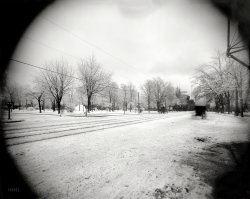
- Detroit Newsies: 1905
- ... Back in the day, Washington was only 4-5 blocks long from Grand Circus Park south the Michigan Avenue. The road changed names - south of ... Posted by Dave - 01/03/2017 - 4:26pm -
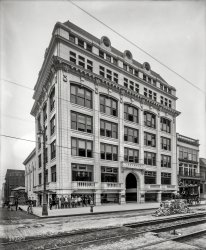
- Detroit Police and RCMP: 1951
- ... hotel (since demolished) located on Washington Blvd, near Grand Circus Park in downtown Detroit. View full size.
RCMP uniforms ... Posted by DetroitScott - 06/07/2013 - 6:08pm -
